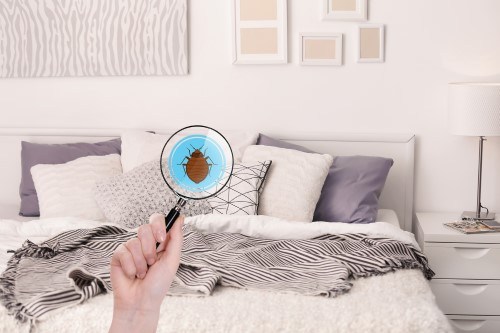
Bedbugs have been around since the time of the dinosaurs and chances are that they will outlive mankind. The last two decades have seen a rapid spread of bedbug infestation. Bedbugs spread very rapidly and are difficult to eradicate. Although their bites can leave itchy marks on your skin along with leaving stains on your bedding, bedbugs do not pose any serious threat to humans. This is because unlike ticks or mosquitoes, bedbugs do not transmit any disease.
If you think that your house may be home to bedbugs – either a few or a full-blown infestation, you need to take the following steps to deal with them.
Step 1 – Identification
Telltale signs on your bedding and itchy marks on your skin could be a sign that you have these unwelcome critters in your home. However, to be sure, look for the characteristic fecal stains (black or brown like a small dot) on your bedding and bed. Hiding in cracks and gaps in your bed or under the mattress, bedbugs get active at night, when their food source, that is you, is available. Arm yourself with a strong flashlight and look for the bugs themselves, their eggs, and skin casts. The internet is full of pictures of bedbugs during various stages of their life cycle; hence, it should not be too difficult to identify them. However, be aware that there are many lookalikes such as spider beetles, bat bugs and carpet beetles.
Step 2 – Do not Panic
You have identified the problem and are now wondering what to do. Just because you have bedbugs in your home does not mean that you need to move out of the furniture, get rid of the mattress, send the carpet for cleaning and get down to spraying pesticides all over the house. You just might end up spreading the bedbugs all over the house. That brings up the question, how to deal with bed bugs? The best thing to do is to remain calm, not do anything in haste. While trying to eradicate them with DIY solutions might be cheaper, it is wiser to be sure that the problem has been taken care of completely. This is where you need to call in the experts.
Step 3 – Bring in the Experts
DIY treatments are not recommended for several reasons. The first is safety. Spraying insecticides or pesticides in your home should only be done after you are sure of the active ingredients and their effect on humans and other pets in the house. The second reason is effectiveness. Having developed resistance to many DIY insecticides, bedbugs may not get affected by them. It could just make the problem worse if the bedbugs scatter and infest the rest of the house.
Effective bedbug eradication methods include heat and steam treatment, using dusting powders, and spraying growth-inhibiting chemicals. However, all these treatments require equipment and trained personnel. The best way to go about getting rid of bedbugs from your home is to call in a pest control operator. A good pest control operator would use a multi-pronged approach to the treatment with follow-up inspections and further treatment if required.
There is no need to throw out anything from your house – neither the mattress nor the bed. Treating your house and all your belongings are the job of the pest control operator. There are certain things that any good pest control operator brings to the table. Before you hire a pest control operator, make sure that the following points are covered in the offer.
- Conduct a comprehensive and careful inspection of the entire house to determine the extent of the problem.
- Confirm the presence of bedbugs, even if you believe that you have an infestation, and provide proof in the form of live/dead bedbugs, eggs, or skin casings.
- An Integrated Pest Management approach requiring numerous methods and tools should be the plan offered for ridding your home of the problem.
- There is no blanket solution for every home. The pest control operator should recommend a plan specific to your home and explain the different methods of treatment to be utilized.
- All costs, warranties and any add-ons should be in writing along with the types of treatments to be used, coverage area, and the number of follow-up inspections/treatments.
Step 4 – Prevent re-infestation
- Once your home is rid of bedbugs, help prevent a re-infestation with these simple steps.
- Avoid places where there is a chance of being exposed to bedbugs.
- Keep your home uncluttered and wash your bedding and clothes at high temperatures settings.
- Inspect your home regularly for any signs of a re-infestation. Early detection is half the battle won.